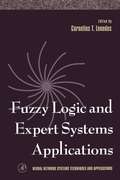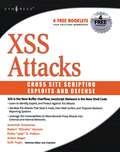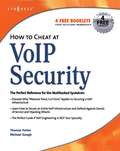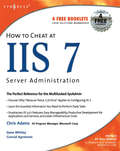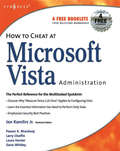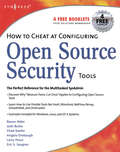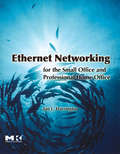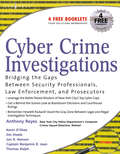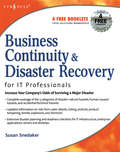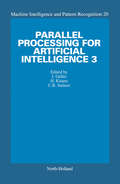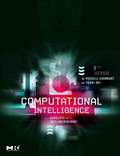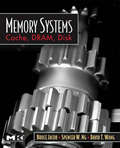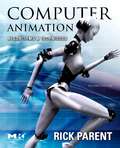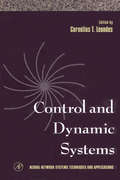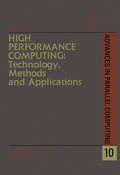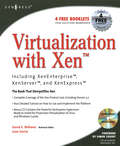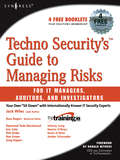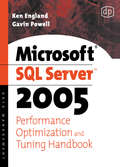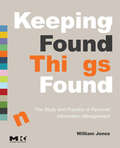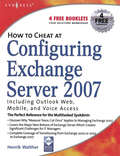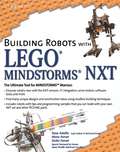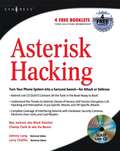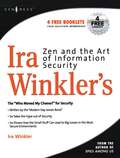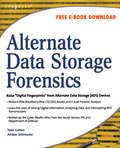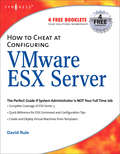- Table View
- List View
Fuzzy Logic and Expert Systems Applications (ISSN #Volume 6)
by Cornelius T. LeondesThis volume covers the integration of fuzzy logic and expert systems. A vital resource in the field, it includes techniques for applying fuzzy systems to neural networks for modeling and control, systematic design procedures for realizing fuzzy neural systems, techniques for the design of rule-based expert systems using the massively parallel processing capabilities of neural networks, the transformation of neural systems into rule-based expert systems, the characteristics and relative merits of integrating fuzzy sets, neural networks, genetic algorithms, and rough sets, and applications to system identification and control as well as nonparametric, nonlinear estimation. Practitioners, researchers, and students in industrial, manufacturing, electrical, and mechanical engineering, as well as computer scientists and engineers will appreciate this reference source to diverse application methodologies.Fuzzy system techniques applied to neural networks for modeling and controlSystematic design procedures for realizing fuzzy neural systemsTechniques for the design of rule-based expert systemsCharacteristics and relative merits of integrating fuzzy sets, neural networks, genetic algorithms, and rough setsSystem identification and controlNonparametric, nonlinear estimation Practitioners, researchers, and students in industrial, manufacturing, electrical, and mechanical engineering, as well as computer scientists and engineers will find this volume a unique and comprehensive reference to these diverse application methodologies
XSS Attacks: Cross Site Scripting Exploits and Defense
by Seth Fogie Jeremiah Grossman Robert Hansen Anton Rager Petko D. PetkovA cross site scripting attack is a very specific type of attack on a web application. It is used by hackers to mimic real sites and fool people into providing personal data.XSS Attacks starts by defining the terms and laying out the ground work. It assumes that the reader is familiar with basic web programming (HTML) and JavaScript. First it discusses the concepts, methodology, and technology that makes XSS a valid concern. It then moves into the various types of XSS attacks, how they are implemented, used, and abused. After XSS is thoroughly explored, the next part provides examples of XSS malware and demonstrates real cases where XSS is a dangerous risk that exposes internet users to remote access, sensitive data theft, and monetary losses. Finally, the book closes by examining the ways developers can avoid XSS vulnerabilities in their web applications, and how users can avoid becoming a victim. The audience is web developers, security practitioners, and managers.XSS Vulnerabilities exist in 8 out of 10 Web sitesThe authors of this book are the undisputed industry leading authoritiesContains independent, bleeding edge research, code listings and exploits that can not be found anywhere else
How to Cheat at VoIP Security (How to Cheat)
by Michael Gough Thomas Porter, CISSP, CCNP, CCDA, CCSThe Perfect Reference for the Multitasked SysAdminThis is the perfect guide if VoIP engineering is not your specialty. It is the perfect introduction to VoIP security, covering exploit tools and how they can be used against VoIP (Voice over IP) systems. It gives the basics of attack methodologies used against the SIP and H.323 protocols as well as VoIP network infrastructure. * VoIP Isn’t Just Another Data ProtocolIP telephony uses the Internet architecture, similar to any other data application. However, from a security administrator’s point of view, VoIP is different. Understand why. * What Functionality Is Gained, Degraded, or Enhanced on a VoIP Network?Find out the issues associated with quality of service, emergency 911 service, and the major benefits of VoIP.* The Security Considerations of Voice MessagingLearn about the types of security attacks you need to protect against within your voice messaging system.* Understand the VoIP Communication ArchitecturesUnderstand what PSTN is and what it does as well as the H.323 protocol specification, and SIP Functions and features.* The Support Protocols of VoIP EnvironmentsLearn the services, features, and security implications of DNS, TFTP, HTTP, SNMP, DHCP, RSVP, SDP, and SKINNY.* Securing the Whole VoIP InfrastructureLearn about Denial-of-Service attacks, VoIP service disruption, call hijacking and interception, H.323-specific attacks, and SIP-specific attacks.* Authorized Access Begins with AuthenticationLearn the methods of verifying both the user identity and the device identity in order to secure a VoIP network.* Understand Skype SecuritySkype does not log a history like other VoIP solutions; understand the implications of conducting business over a Skype connection.* Get the Basics of a VoIP Security PolicyUse a sample VoIP Security Policy to understand the components of a complete policy.Provides system administrators with hundreds of tips, tricks, and scripts to complete administration tasks more quickly and efficientlyShort on theory, history, and technical data that ultimately is not helpful in performing their jobsAvoid the time drains associated with securing VoIP
How to Cheat at IIS 7 Server Administration (How to Cheat)
by Brian Frederick Pattrick SantryAccording to Microsoft, Internet Information Services (IIS) 7.0 is a web server that provides a secure, easy to manage platform for developing and reliably hosting Web applications and services. With the new version of IIS, there are more security options, 40 new feature models that allow administrators to customize their settings, and a new set of administration tools. Administrators migrating from version 6 will find this How to Cheat book the perfect vehicle for getting up to speed fast on the new version.IIS version 7 is the perfect product for the How to Cheat series. This new version from Microsoft is an ambitious overhaul that tries to balance the growing needs for performance, cost effectiveness, and security. For the average SysAdmin, it will present a difficult migration path from earlier versions and a vexing number of new features. How to Cheat promises help get IIS 7 up and running as quickly and safely as possible.Provides the multi-tasked SysAdmin with the essential information needed to perform the daily tasksEmphasizes best-practice security measuresCover the major new release of IIS 7, which will create significant challenges for IT managers
How to Cheat at Microsoft Vista Administration (How to Cheat)
by Jan Kanclirz Jr.The Perfect Reference for the Multitasked SysAdminThe Microsoft Windows Vista operating system offers several changes and improvements over its predecessors. It not only brings a new and redesigned interface, but also improves on many administrative utilities and management consoles. It also enhances the system’s reliability, performance, and problem-solving tools. As administrators, Vista will sometimes look like its predecessor, Windows XP, and at other times, look like an all-new operating system. How to Cheat will help you get Vista up and running as quickly and safely as possible and provide you with a solid idea of all the important changes and improvements the new Microsoft Vista OS has to offer.In the book you will:* Automate Windows Vista InstallationSee how Windows installations can be automated for large-scale deployments using the Windows Automated Installation Kit (WAIK).* Install and Maintain DevicesWindows Vista contains device drivers for hundreds of PnP devices, and the Device Manager snap-in is the main utility on a local computer for managing them.* Customize Appearances, Taskbars, and ToolbarsSee how to use a personalization page, use the taskbar, and customize desktop themes.* Manage File System Formats, Partitions, and VolumesLearn how Windows Vista supports basic and dynamic volumes and two partition styles: MBR and GPT.* Increase File System PerformanceLearn how using tools such as disk defragging, cluster size adjustment, removing short filename support, and compression can help with performance.* Administer via RemoteRemote Desktop and Windows Firewall can help administrators perform administrative tasks on remote computers.* Managing ServicesThe Services utility allows you to view the status of services, as well as to disable nonessential services.* Configure TCP/IP in VistaSee how to configure TCP/IP (both IPv4 and IPv6) via the user interface or via the netsh command.* See What’s New with Wireless in VistaUnderstand wireless security and learn how to install a wireless network.* Optimize Windows Startup, the Hard Disk, and MoreOptimize memory, applications, and the network connection, and see how to monitor performance.Contents IncludeIntroducing and Installing Microsoft VistaInstalling and Maintaining Hardware Devices and DriversCustomizing Desktop PropertiesManaging File Systems and DisksGeneral Administration TasksManaging Local Networking EssentialsManaging the Wireless World and Its SecurityManaging Security EssentialsSecuring User AccessTuning for Better Performance TroubleshootingProvides the multi-tasked SysAdmin with the essential information needed to perform the daily tasksCovers the major new release of Windows, which will create significant challenges for IT managersEmphasizes best-practice security measures
How to Cheat at Configuring Open Source Security Tools (How to Cheat)
by Michael Gregg Eric Seagren Angela Orebaugh Matt Jonkman Raffael MartyThe Perfect Reference for the Multitasked SysAdminThis is the perfect guide if network security tools is not your specialty. It is the perfect introduction to managing an infrastructure with freely available, and powerful, Open Source tools. Learn how to test and audit your systems using products like Snort and Wireshark and some of the add-ons available for both. In addition, learn handy techniques for network troubleshooting and protecting the perimeter.* Take InventorySee how taking an inventory of the devices on your network must be repeated regularly to ensure that the inventory remains accurate.* Use NmapLearn how Nmap has more features and options than any other free scanner.* Implement FirewallsUse netfilter to perform firewall logic and see how SmoothWall can turn a PC into a dedicated firewall appliance that is completely configurable.* Perform Basic HardeningPut an IT security policy in place so that you have a concrete set of standards against which to measure. * Install and Configure Snort and WiresharkExplore the feature set of these powerful tools, as well as their pitfalls and other security considerations.* Explore Snort Add-OnsUse tools like Oinkmaster to automatically keep Snort signature files current.* Troubleshoot Network ProblemsSee how to reporting on bandwidth usage and other metrics and to use data collection methods like sniffing, NetFlow, and SNMP.* Learn Defensive Monitoring ConsiderationsSee how to define your wireless network boundaries, and monitor to know if they’re being exceeded and watch for unauthorized traffic on your network.Covers the top 10 most popular open source security tools including Snort, Nessus, Wireshark, Nmap, and KismetFollows Syngress' proven "How to Cheat" pedagogy providing readers with everything they need and nothing they don't
Ethernet Networking for the Small Office and Professional Home Office
by Jan L. HarringtonIn a local area network (LAN) or intranet, there are many pieces of hardare trying to gain access to the network transmission media at the same time (i.e., phone lines, coax, wireless, etc.). However, a network cable or wireless transmission frequency can physically only allow one node to use it at a given time. Therefore, there must be some way to regulate which node has control of the medium (a media access control, or MAC, protocol). Ethernet is a MAC protocol; it is one way to regulate physical access to network tranmission media. Ethernet networking is used primarily by networks that are contained within a single physical location. If you need to design, install, and manage a network in such an envronment, i.e., home or small business office, then Ethernet Networking for the Small Office and Professional Home Office will give you an in-depth understanding of the technology involved in an Ethernet network. One of the major goals of this book is to demystify the jargon of networks so that the reader gains a working familiarity with common networking terminology and acronyms. In addition, this books explains not only how to choose and configure network hardware but also provides practical information about the types of network devices and software needed to make it all work. Tips and direction on how to manage an Ethernet network are also provided. This book therefore goes beyond the hardware aspects of Ethernet to look at the entire network from bottom to top, along with enough technical detail to enable the reader to make intelligent choices about what types of transmission media are used and the way in which the various parts of the network are interconnected.Explains how the Ethernet works, with emphasis on current technologies and emerging trends in gigabit and fast Ethernet, WiFi, routers, and security issuesTeaches how to design and select complementary components of Ethernet networks with a focus on home and small business applicationsDiscuses the various types of cables, software, and hardware involved in constructing, connecting, operating and monitoring Ethernet networks
Cyber Crime Investigations: Bridging the Gaps Between Security Professionals, Law Enforcement, and Prosecutors
by James Steele Anthony Reyes Richard Brittson Kevin O'SheaWritten by a former NYPD cyber cop, this is the only book available that discusses the hard questions cyber crime investigators are asking.The book begins with the chapter “What is Cyber Crime?" This introductory chapter describes the most common challenges faced by cyber investigators today. The following chapters discuss the methodologies behind cyber investigations; and frequently encountered pitfalls. Issues relating to cyber crime definitions, the electronic crime scene, computer forensics, and preparing and presenting a cyber crime investigation in court will be examined. Not only will these topics be generally be discussed and explained for the novice, but the hard questions —the questions that have the power to divide this community— will also be examined in a comprehensive and thoughtful manner. This book will serve as a foundational text for the cyber crime community to begin to move past current difficulties into its next evolution.This book has been written by a retired NYPD cyber cop, who has worked many high-profile computer crime casesDiscusses the complex relationship between the public and private sector with regards to cyber crimeProvides essential information for IT security professionals and first responders on maintaining chain of evidence
Business Continuity and Disaster Recovery Planning for IT Professionals
by Susan SnedakerPowerful Earthquake Triggers Tsunami in Pacific. Hurricane Katrina Makes Landfall in the Gulf Coast. Avalanche Buries Highway in Denver. Tornado Touches Down in Georgia. These headlines not only have caught the attention of people around the world, they have had a significant effect on IT professionals as well. As technology continues to become more integral to corporate operations at every level of the organization, the job of IT has expanded to become almost all-encompassing. These days, it’s difficult to find corners of a company that technology does not touch. As a result, the need to plan for potential disruptions to technology services has increased exponentially. That is what Business Continuity Planning (BCP) is: a methodology used to create a plan for how an organization will recover after a disaster of various types. It takes into account both security and corporate risk management tatics.There is a lot of movement around this initiative in the industry: the British Standards Institute is releasing a new standard for BCP this year. Trade shows are popping up covering the topic.* Complete coverage of the 3 categories of disaster: natural hazards, human-caused hazards, and accidental and technical hazards.* Only published source of information on the new BCI standards and government requirements.* Up dated information on recovery from cyber attacks, rioting, protests, product tampering, bombs, explosions, and terrorism.
Parallel Processing for Artificial Intelligence 3 (ISSN #Volume 20)
by J. Geller H. Kitano C. B. SuttnerThe third in an informal series of books about parallel processing for Artificial Intelligence, this volume is based on the assumption that the computational demands of many AI tasks can be better served by parallel architectures than by the currently popular workstations. However, no assumption is made about the kind of parallelism to be used. Transputers, Connection Machines, farms of workstations, Cellular Neural Networks, Crays, and other hardware paradigms of parallelism are used by the authors of this collection.The papers arise from the areas of parallel knowledge representation, neural modeling, parallel non-monotonic reasoning, search and partitioning, constraint satisfaction, theorem proving, parallel decision trees, parallel programming languages and low-level computer vision. The final paper is an experience report about applications of massive parallelism which can be said to capture the spirit of a whole period of computing history.This volume provides the reader with a snapshot of the state of the art in Parallel Processing for Artificial Intelligence.
Computational Intelligence: Concepts to Implementations
by Russell C. Eberhart Yuhui ShiComputational Intelligence: Concepts to Implementations provides the most complete and practical coverage of computational intelligence tools and techniques to date. This book integrates various natural and engineering disciplines to establish Computational Intelligence. This is the first comprehensive textbook on the subject, supported with lots of practical examples. It asserts that computational intelligence rests on a foundation of evolutionary computation. This refreshing view has set the book apart from other books on computational intelligence. This book lays emphasis on practical applications and computational tools, which are very useful and important for further development of the computational intelligence field. Focusing on evolutionary computation, neural networks, and fuzzy logic, the authors have constructed an approach to thinking about and working with computational intelligence that has, in their extensive experience, proved highly effective. The book moves clearly and efficiently from concepts and paradigms to algorithms and implementation techniques by focusing, in the early chapters, on the specific con. It explores a number of key themes, including self-organization, complex adaptive systems, and emergent computation. It details the metrics and analytical tools needed to assess the performance of computational intelligence tools. The book concludes with a series of case studies that illustrate a wide range of successful applications. This book will appeal to professional and academic researchers in computational intelligence applications, tool development, and systems.Moves clearly and efficiently from concepts and paradigms to algorithms and implementation techniques by focusing, in the early chapters, on the specific concepts and paradigms that inform the authors' methodologiesExplores a number of key themes, including self-organization, complex adaptive systems, and emergent computationDetails the metrics and analytical tools needed to assess the performance of computational intelligence toolsConcludes with a series of case studies that illustrate a wide range of successful applicationsPresents code examples in C and C++Provides, at the end of each chapter, review questions and exercises suitable for graduate students, as well as researchers and practitioners engaged in self-study
Memory Systems: Cache, DRAM, Disk
by David Wang Bruce Jacob Spencer NgIs your memory hierarchy stopping your microprocessor from performing at the high level it should be? Memory Systems: Cache, DRAM, Disk shows you how to resolve this problem. The book tells you everything you need to know about the logical design and operation, physical design and operation, performance characteristics and resulting design trade-offs, and the energy consumption of modern memory hierarchies. You learn how to to tackle the challenging optimization problems that result from the side-effects that can appear at any point in the entire hierarchy.As a result you will be able to design and emulate the entire memory hierarchy.Understand all levels of the system hierarchy -Xcache, DRAM, and disk. Evaluate the system-level effects of all design choices.Model performance and energy consumption for each component in the memory hierarchy.
Computer Animation: Algorithms and Techniques (The Morgan Kaufmann Series in Computer Graphics)
by Rick ParentDriven by the demands of research and the entertainment industry, the techniques of animation are pushed to render increasingly complex objects with ever-greater life-like appearance and motion. This rapid progression of knowledge and technique impacts professional developers, as well as students. Developers must maintain their understanding of conceptual foundations, while their animation tools become ever more complex and specialized. The second edition of Rick Parent's Computer Animation is an excellent resource for the designers who must meet this challenge. The first edition established its reputation as the best technically oriented animation text. This new edition focuses on the many recent developments in animation technology, including fluid animation, human figure animation, and soft body animation. The new edition revises and expands coverage of topics such as quaternions, natural phenomenon, facial animation, and inverse kinematics. The book includes up-to-date discussions of Maya scripting and the Maya C++ API, programming on real-time 3D graphics hardware, collision detection, motion capture, and motion capture data processing.New up-to-the-moment coverage of hot topics like real-time 3D graphics, collision detection, fluid and soft-body animation and more!Companion site with animation clips drawn from research & entertainment and code samplesDescribes the mathematical and algorithmic foundations of animation that provide the animator with a deep understanding and control of technique
Neural Network Systems Techniques and Applications: Advances in Theory and Applications (ISSN #Volume 7)
by Cornelius T. LeondesThe book emphasizes neural network structures for achieving practical and effective systems, and provides many examples. Practitioners, researchers, and students in industrial, manufacturing, electrical, mechanical,and production engineering will find this volume a unique and comprehensive reference source for diverse application methodologies. Control and Dynamic Systems covers the important topics of highly effective Orthogonal Activation Function Based Neural Network System Architecture, multi-layer recurrent neural networks for synthesizing and implementing real-time linear control,adaptive control of unknown nonlinear dynamical systems, Optimal Tracking Neural Controller techniques, a consideration of unified approximation theory and applications, techniques for the determination of multi-variable nonlinear model structures for dynamic systems with a detailed treatment of relevant system model input determination, High Order Neural Networks and Recurrent High Order Neural Networks, High Order Moment Neural Array Systems, Online Learning Neural Network controllers, and Radial Bias Function techniques.Coverage includes: Orthogonal Activation Function Based Neural Network System Architecture (OAFNN)Multilayer recurrent neural networks for synthesizing and implementing real-time linear controlAdaptive control of unknown nonlinear dynamical systemsOptimal Tracking Neural Controller techniquesConsideration of unified approximation theory and applicationsTechniques for determining multivariable nonlinear model structures for dynamic systems, with a detailed treatment of relevant system model input determination
High Performance Computing: Technology, Methods and Applications (ISSN #Volume 10)
by J. J. Dongarra L. Grandinetti J. Kowalik G. R. JoubertHigh Performance Computing is an integrated computing environment for solving large-scale computational demanding problems in science, engineering and business. Newly emerging areas of HPC applications include medical sciences, transportation, financial operations and advanced human-computer interface such as virtual reality. High performance computing includes computer hardware, software, algorithms, programming tools and environments, plus visualization.The book addresses several of these key components of high performance technology and contains descriptions of the state-of-the-art computer architectures, programming and software tools and innovative applications of parallel computers. In addition, the book includes papers on heterogeneous network-based computing systems and scalability of parallel systems.The reader will find information and data relative to the two main thrusts of high performance computing: the absolute computational performance and that of providing the most cost effective and affordable computing for science, industry and business. The book is recommended for technical as well as management oriented individuals.
Virtualization with Xen(tm): Including XenEnterprise, XenServer, and XenExpress
by David E. WilliamsComplete Coverage of Xen, Including Version 3.2Virtualization with Xen is the first book to demonstrate to readers how to install, administer, and maintain a virtual infrastructure based on XenSource’s latest release, Xen 3.2. It discusses best practices for setting up a Xen environment correctly the first time, maximizing the utilization of server assets while taking advantage of the fastest and most secure enterprise-grade paravirtualization architecture. It covers both basic and advanced topics, such as planning and installation, physical-to-virtual migrations, virtual machine provisioning, resource management, and monitoring and troubleshooting guests and Xen hosts.* Explore Xen’s Virtualization ModelFind a complete overview of the architecture model as well of all products: Xen 3.0 , Xen Express, XenServer, and Xen Enterprise.* Deploy XenUnderstand the system requirements, learn installation methods, and see how to install Xen on a free Linux distribution.* Master the Administrator ConsoleLearn how to use the command-line tools and the remote Java-based consoler that manages the configuration and operations of XenServer hosts and VMs.* Manage Xen with Third-Party ToolsUse products like openQRM, Enomalism, and Project ConVirt to manage the VMM.* Deploy a Virtual Machine in XenLearn about workload planning and installing modified guests, unmodified guests, and Windows guests.* Explore Advanced Xen ConceptsBuild a Xen Cluster, complete a XenVM migration, and discover XenVM backup and recovery solutions.* See the Future of VirtualizationSee the unofficial Xen road map and what virtual infrastructure holds for tomorrow’s data center.* See Other Virtualization Technologies and How They Compare with XenTake a look at the different types of server virtualization, other virtual machine software available, and how they compare with Xen.Xen has the lead in the open-source community; now distributed as a standard kernel package for Novell’s SLES 10 and Red Hat’s RHEL 5 and Fedora Core 6 Linux distributionsCovers installation, administration, management, monitoring, and deployment planning and strategies
Techno Security's Guide to Managing Risks for IT Managers, Auditors, and Investigators
by Johnny Long Jack Wiles Russ Rogers Phil Drake Ron J. Green Greg Kipper Raymond Todd Blackwood Amber Schroader“This book contains some of the most up-to-date information available anywhere on a wide variety of topics related to Techno Security. As you read the book, you will notice that the authors took the approach of identifying some of the risks, threats, and vulnerabilities and then discussing the countermeasures to address them. Some of the topics and thoughts discussed here are as new as tomorrow’s headlines, whereas others have been around for decades without being properly addressed. I hope you enjoy this book as much as we have enjoyed working with the various authors and friends during its development." —Donald Withers, CEO and Cofounder of TheTrainingCo.• Jack Wiles, on Social Engineering offers up a potpourri of tips, tricks, vulnerabilities, and lessons learned from 30-plus years of experience in the worlds of both physical and technical security.• Russ Rogers on the Basics of Penetration Testing illustrates the standard methodology for penetration testing: information gathering, network enumeration, vulnerability identification, vulnerability exploitation, privilege escalation, expansion of reach, future access, and information compromise. • Johnny Long on No Tech Hacking shows how to hack without touching a computer using tailgating, lock bumping, shoulder surfing, and dumpster diving.• Phil Drake on Personal, Workforce, and Family Preparedness covers the basics of creating a plan for you and your family, identifying and obtaining the supplies you will need in an emergency.• Kevin O’Shea on Seizure of Digital Information discusses collecting hardware and information from the scene.• Amber Schroader on Cell Phone Forensics writes on new methods and guidelines for digital forensics.• Dennis O’Brien on RFID: An Introduction, Security Issues, and Concerns discusses how this well-intended technology has been eroded and used for fringe implementations.• Ron Green on Open Source Intelligence details how a good Open Source Intelligence program can help you create leverage in negotiations, enable smart decisions regarding the selection of goods and services, and help avoid pitfalls and hazards. • Raymond Blackwood on Wireless Awareness: Increasing the Sophistication of Wireless Users maintains it is the technologist’s responsibility to educate, communicate, and support users despite their lack of interest in understanding how it works.• Greg Kipper on What is Steganography? provides a solid understanding of the basics of steganography, what it can and can’t do, and arms you with the information you need to set your career path.• Eric Cole on Insider Threat discusses why the insider threat is worse than the external threat and the effects of insider threats on a company.Internationally known experts in information security share their wisdomFree pass to Techno Security Conference for everyone who purchases a book—$1,200 value
Microsoft SQL Server 2005 Performance Optimization and Tuning Handbook
by Ken England Gavin JT PowellDatabase professionals will find that this new edition aids in mastering the latest version of Microsoft’s SQL Server. Developers and database administrators (DBAs) use SQL on a daily basis in application development and the subsequent problem solving and fine tuning. Answers to SQL issues can be quickly located helping the DBA or developer optimize and tune a database to maximum efficiency.Basic questions are easily located on the topics of filtering, sorting, operators, conditionals, pseudo columns, single row functions, joins, grouping functions, sub queries, composite queries, hierarchies, flashback queries, parallel queries, expressions and regular expressions. Assistance on DML, data types (including collections), XML, DDL for basic database objects such as tales, views and indexes, partitioning, and security is also considered.* Identifies and discusses the most common issues database administrators (DBAs) face day-to-day*Provides DBAs with solutions actually used by the authors in enterprise environments*Explores new features which add more control but reduce performance
Keeping Found Things Found: The Study and Practice of Personal Information Management (Interactive Technologies)
by William JonesKeeping Found Things Found: The Study and Practice of Personal Information Management is the first comprehensive book on new 'favorite child' of R&D at Microsoft and elsewhere, personal information management (PIM). It provides a comprehensive overview of PIM as both a study and a practice of the activities people do, and need to be doing, so that information can work for them in their daily lives. It explores what good and better PIM looks like, and how to measure improvements. It presents key questions to consider when evaluating any new PIM informational tools or systems. This book is designed for R&D professionals in HCI, data mining and data management, information retrieval, and related areas, plus developers of tools and software that include PIM solutions.Focuses exclusively on one of the most interesting and challenging problems in today's worldExplores what good and better PIM looks like, and how to measure improvementsPresents key questions to consider when evaluating any new PIM informational tools or systems
How to Cheat at Configuring Exchange Server 2007: Including Outlook Web, Mobile, and Voice Access (How to Cheat)
by Henrik WaltherThe Perfect Reference for the Multitasked System AdministratorsThe new version of Exchange is an ambitious overhaul that tries to balance the growing needs for performance, cost effectiveness, and security. For the average system administrator, it will present a difficult migration path from earlier versions and a vexing number of new features. How to Cheat will help you get Exchange Server 2007 up and running as quickly and safely as possible.• Understand Exchange 2007 PrerequisitesReview hardware and software requirements, Active Directory requirements, and more.• Manage Recipient FilteringCreate a custom MMC that contains the Exchange 2007 Recipients work center, which can be used, for example, by the helpdesk staff in your organization.• Manage Outlook AnywhereOutlook Anywhere makes it possible for your end users to remotely access their mailboxes from the Internet using their full Outlook clients.• Manage Outlook Web Access 2007See how Outlook Web Access 2007 was completely rewritten in managed code to make it scale even better.• Use the Exchange 2007 Queue ViewerYou can now view information about queues and examine the messages held within them.• Master Powerful Out-of-the-Box Spam ProtectionThe Edge Transport server supports SMTP, provides several antispam filtering agents, and supports antivirus extensibility.• Manage a Single-Copy Cluster-Based SetupSCC-based cluster provides service failover and still has a single point of failure when it comes to the databases.• Recover Mailbox DatabasesUse the improved database portability feature to port and recover a Mailbox database to any server in the Exchange 2007 organization.Essential information for the multi-tasked System Administrator charged perform everyday tasksIncludes the latest coverage of the major new release of Exchange ServerEmphasizes best-practice security measures for all areas and in particular the area of remote access via Outlook
Building Robots with LEGO Mindstorms NXT
by Mario Ferrari Guilio FerrariThe Ultimate Tool for MINDSTORMS® ManiacsThe new MINDSTORMS kit has been updated to include a programming brick, USB cable, RJ11-like cables, motors, and sensors. This book updates the robotics information to be compatible with the new set and to show how sound, sight, touch, and distance issues are now dealt with. The LEGO MINDSTORMS NXT and its predecessor, the LEGO MINDSTORMS Robotics Invention System (RIS), have been called "the most creative play system ever developed." This book unleashes the full power and potential of the tools, sensors, and components that make up LEGO MINDSTORMS NXT. It also provides a unique insight on newer studless building techniques as well as interfacing with the traditional studded beams. Some of the world's leading LEGO MINDSTORMS inventors share their knowledge and development secrets. You will discover an incredible range of ideas to inspire your next invention. This is the ultimate insider's look at LEGO MINDSTORMS NXT system and is the perfect book whether you build world-class competitive robots or just like to mess around for the fun of it.Featuring an introduction by astronaut Dan Barry and written by Dave Astolfo, Invited Member of the MINDSTORMS Developer Program and MINDSTORMS Community Partners (MCP) groups, and Mario and Guilio Ferrari, authors of the bestselling Building Robots with LEGO Mindstorms, this book covers:Understanding LEGO GeometryPlaying with GearsControlling MotorsReading SensorsWhat's New with the NXT?Building StrategiesProgramming the NXTPlaying Sounds and MusicBecoming MobileGetting Pumped: PneumaticsFinding and Grabbing ObjectsDoing the MathKnowing Where You AreClassic ProjectsBuilding Robots That WalkRobotic AnimalsSolving a MazeDrawing and WritingRacing Against TimeHand-to-Hand CombatSearching for PrecisionComplete coverage of the new Mindstorms NXT kitBrought to you by the DaVinci's of LEGOUpdated edition of a bestseller
Asterisk Hacking
by Joshua BrasharsAsterisk Hacking provides detials of techniques people may not be aware of. It teaches the secrets the bad guys already know about stealing personal information through the most common, seemingly innocuous, highway into computer networks: the phone system. This book provides detials to readers what they can do to protect themselves, their families, their clients, and their network from this invisible threat. Power tips show how to make the most out of the phone system for defense or attack.Contains original code to perform previously unthought of tasks like changing caller id, narrowing a phone number down to a specific geographic location, and more!See through the eyes of the attacker and learn WHY they are motivated, something not touched upon in most other titles.
Zen and the Art of Information Security
by Ira WinklerWhile security is generally perceived to be a complicated and expensive process, Zen and the Art of Information Security makes security understandable to the average person in a completely non-technical, concise, and entertaining format. Through the use of analogies and just plain common sense, readers see through the hype and become comfortable taking very simple actions to secure themselves. Even highly technical people have misperceptions about security concerns and will also benefit from Ira Winkler’s experiences making security understandable to the business world. Mr. Winkler is one of the most popular and highly rated speakers in the field of security, and lectures to tens of thousands of people a year. Zen and the Art of Information Security is based on one of his most well received international presentations.Written by an internationally renowned author of Spies Among Us who travels the world making security presentations to tens of thousands of people a yearThis short and concise book is specifically for the business, consumer, and technical user short on time but looking for the latest information along with reader friendly analogiesDescribes the REAL security threats that you have to worry about, and more importantly, what to do about them
Alternate Data Storage Forensics
by Amber Schroader Tyler CohenLearn to pull “digital fingerprints" from alternate data storage (ADS) devices including: iPod, Xbox, digital cameras and more from the cyber sleuths who train the Secret Service, FBI, and Department of Defense in bleeding edge digital forensics techniques. This book sets a new forensic methodology standard for investigators to use.This book begins by describing how alternate data storage devices are used to both move and hide data. From here a series of case studies using bleeding edge forensic analysis tools demonstrate to readers how to perform forensic investigations on a variety of ADS devices including: Apple iPods, Digital Video Recorders, Cameras, Gaming Consoles (Xbox, PS2, and PSP), Bluetooth devices, and more using state of the art tools. Finally, the book takes a look into the future at “not yet every day" devices which will soon be common repositories for hiding and moving data for both legitimate and illegitimate purposes.Authors are undisputed leaders who train the Secret Service, FBI, and Department of DefenseBook presents "one of a kind" bleeding edge information that absolutely can not be found anywhere elseToday the industry has exploded and cyber investigators can be found in almost every field
How to Cheat at Configuring VmWare ESX Server (How to Cheat)
by David Rule Jr.A virtual evolution in IT shops large and small has begun. VMware’s ESX Server is the enterprise tool to free your infrastructure from its physical limitations providing the great transformation into a virtual environment--this book shows you how. Use Syngress’ proven “How to Cheat" methodology to configure and build VMware’s ESX Server version 3. This clear, concise guide provides all the information you need to become a virtual whiz!This book will detail the default and custom installation of VMware’s ESX server as well as basic and advanced virtual machine configurations. It will then walk the reader through post installation configurations including installation and configuration of VirtualCenter. From here, readers will learn to efficiently create and deploy virtual machine templates. Best practices for securing and backing up your virtual environment are also provided. The book concludes with a series of handy, time-saving command and configuration for: bash shell keystrokes, Linux commands, configuration files, common/proc files, VMware ESX commands, and troubleshooting.• Reap the Benefits of Server VirtualizationRealize improved ROI, ensure efficient mergers and acquisitions, and reduce compliance risk exposure through server virtualization and consolidation.• Build a Virtual MachineCreate a Gold Master and use your VMlibrary to leverage the power and flexibility of VMware. • Manage Your Virtual InfrastructureUse VMware tools to partition physical servers and manage virtual machines.• Set Up Scripted InstallationSee how a scripted installation method can be a fast and efficient way to provision ESX hosts.• Master ESX Native ToolsUse tools like Esxtop to diagnose performance issues and vmkfstools to import and export• Install and Use VMware Scripting APIsDevelop programs to help automate and ease administration—even with a limited background in scripting or programming.• Learn the Fundamentals of a VM BackupVMware ESX ships with three scripts that work together to create a backup and restore system: vmsnap.pl, vmsnap_all.pl, and vmres.pl.• Extend a Cloned Windows VM’s Root PartitionUse Microsoft’s Sysprep utility to extend a newly deployed virtual machine’s root partition from the original clone size to a larger size.
